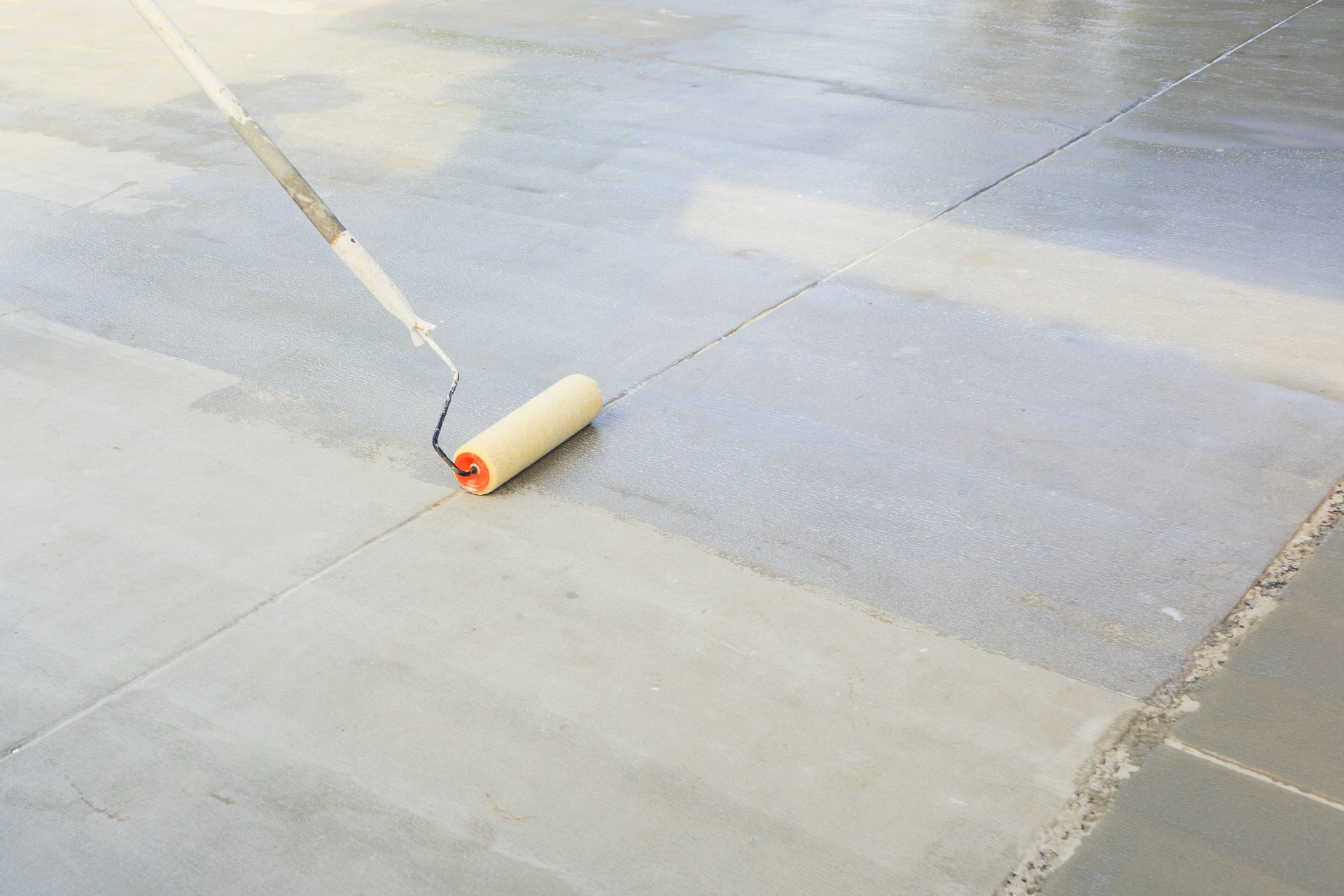While many are familiar with the basic concept of sealing concrete, there is more to the process than meets the eye.
Understanding the different types of sealers and additives, when and how to apply sealer, how to remove concrete sealer, and application techniques and timeframes can significantly impact the effectiveness and outcome of the final result.
1. Sealer Can Make Concrete Slippery
While sealers enhance resistance to stains and weathering, some formulations can make the concrete slick, especially when wet. This slipperiness can pose safety concerns, particularly in areas such as pool decks.
If the surface is likely to be regularly exposed to water or other slippery conditions, select a sealer with slip-resistant additives, or use a penetrating sealer as opposed to a film-forming sealer.
Also, be sure to only apply a thin layer of sealer. Thick layers may produce a glossy finish, but the slickness factor increases greatly.
Balancing the benefits of protection with the need for traction is essential for a successful application that prioritizes safety and durability.
2. Concrete Sealer Isn’t Always Necessary
Contrary to common belief, applying a concrete sealer may not always be necessary for every project.
While sealers offer valuable protection and are typically highly recommended, there are scenarios where they might not be the most suitable solution.
For instance, a covered patio only used occasionally with minimal exposure to harsh weather conditions or heavy foot traffic may not warrant using a sealer.
Understanding the specific needs of the concrete surface, its location, and the anticipated level of wear and tear is crucial in determining whether the application of a sealer is warranted.
3. Different Types of Sealers Are Available
Each type of concrete sealer serves a distinct purpose. Penetrating sealers, acrylic sealers, epoxy sealers, and polyurethane sealers all have distinct characteristics and applications.
The choice of sealer should align with the specific requirements of the concrete surface and the desired outcome.
Penetrating Sealers
These sealers penetrate the pores of the concrete, forming a protective barrier against moisture, salts, and other contaminants, while still allowing the concrete to breathe.
Penetrating sealers are often ideal when you desire protection but want to reduce slipperiness.
Acrylic Sealers
Acrylic sealers create a surface film on the concrete, enhancing its appearance by providing a glossy or matte finish. These sealers are suitable for both interior and exterior applications.
Epoxy Sealers
Epoxy sealers form a strong bond with the concrete surface. They are highly durable and chemically resistant, making them ideal for industrial settings or areas with high traffic.
Polyurethane Sealers
Known for their abrasion resistance and UV stability, polyurethane sealers offer excellent protection against wear, making them suitable for surfaces exposed to heavy use and sunlight.
4. Additives Can Be Used During Application
When using concrete sealers, additives can be introduced during the application process to enhance specific properties.
Slip-resistant additives, for example, help mitigate the potential slipperiness of sealed surfaces to ensure a safer environment.
Other additives may include anti-mold or anti-mildew agents, further tailoring the sealer to the unique requirements of the concrete and its surroundings.
5. When To Apply Concrete Sealer
Ideally, a concrete sealer should be applied once the concrete has cured completely, usually 28 days after installation.
However, factors such as surface moisture and weather conditions can influence the timing.
The concrete must be dry enough for proper adhesion but not so dry that the sealer won’t be absorbed effectively.
Ideal weather conditions for applying concrete sealer include:
- Temperatures between 50°F and 90°F
- Low to moderate humidity
- Calm winds
- Little to no direct sunlight to prevent rapid evaporation

6. How To Apply Concrete Sealer
The application of concrete sealer involves several key steps:
- Surface Preparation: Clean the surface thoroughly, repair any damage, and ensure it’s completely dry.
- Choose the Right Tools: Select the appropriate tools based on the sealer type, such as brushes, rollers, or sprayers.
- Apply Evenly: Ensure an even application, avoiding puddles or uneven coverage.
- Follow Recommended Coverage: Adhere to the manufacturer’s coverage guidelines to achieve optimal results.
- Allow Drying Time: Allow sufficient drying time between coats and before exposing the surface to foot traffic or other uses.
If you need concrete repairs completed before sealing or if you are not comfortable prepping the surface or applying concrete sealer yourself, contact us today at 630-423-6658 to schedule your free estimate.
7. A Thick Layer May Not Be Best
While it might seem logical to apply a thick layer of sealer for added protection, this is not always the case. Thick layers can lead to issues such as uneven drying, bubbling, peeling, or slickness.
Always follow the manufacturer’s recommendations for application thickness to ensure the sealer can bond effectively with the concrete and provide the intended protection without compromising the overall finish.
8. How To Remove Concrete Sealer
Removing concrete sealer is a process that may be necessary when reapplying or if the sealer has become damaged. Common methods include:
- Chemical Strippers: These are applied to break down the sealer, followed by scraping or pressure washing.
- Mechanical Methods: Abrasive techniques, such as sanding or grinding, can remove the sealer mechanically. Be cautious when using these methods with stamped concrete.
- Professional Assistance: For large areas or stubborn sealers, seeking professional help may be more efficient and ensure proper removal without damaging the concrete.
9. How Often To Reapply Concrete Sealer
The ideal frequency for reapplying a concrete sealer depends on several factors.
Areas subjected to high levels of foot or vehicular traffic may demand more frequent reapplication.
Additionally, surfaces exposed to harsh weather conditions, UV radiation, or chemicals may require more regular maintenance.
The type of sealer used also plays a crucial role as different sealers have varying lifespans. It’s best to follow the manufacturer’s recommendations.
Regular inspections of the sealed surface provide valuable insights into its condition, helping you gauge when reapplication is necessary.
If you’re unsure of your concrete’s current conditions and needs, consult a professional for an evaluation and recommendations.
10. Concrete Sealers Are Not a Fix for Structural Issues
Although sealers provide surface protection, they do not address underlying structural problems. Any cracks, spalling, or other structural issues should be addressed and repaired separately.
Using sealers as a bandage solution for structural issues can lead to ongoing problems and can compromise the long-term integrity of the concrete.

